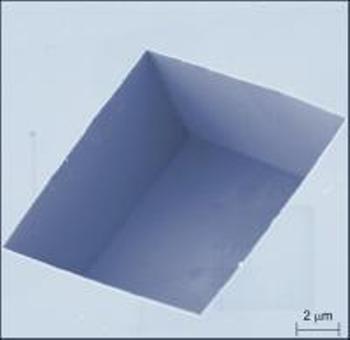Researchers at the National Institute of Standards and Technology have developed a new chemical process to make incisions in diamonds so that they can be effectively used in micro-electromechanical systems (MEMS).
 This colorized electron microscope image reveals the boxy shape of the pits the NIST team etched into the diamond surface, exhibiting their smooth vertical sidewalls and flat bottom. The pits were between 1 and 72 micrometers in size.
This colorized electron microscope image reveals the boxy shape of the pits the NIST team etched into the diamond surface, exhibiting their smooth vertical sidewalls and flat bottom. The pits were between 1 and 72 micrometers in size.
According to this method, small holes are created in the surface of the diamond through a chemical etching process. Initially researchers formed cavities measuring 1 to 72 µm, having smooth walls on the side and a flat base. However the rate at which the chemical process can make these cavities is very slow as this totally depends on the orientation of the diamond cube’s faces planes. These face planes also determine the time when the etching process can be stopped.
The semiconductor industry has been instrumental in the development of electronic microchips for computers. In recent times, the industry has expanded its reach by developing MEMS which measure only a few micrometres and can sense changes in the environment such as acceleration, pressure and temperature. This ability of MEMS makes them a foundation for sensing devices. In order to make the sliding or moving parts last longer, manufacturers require a material that is durable and lasts long. Researchers have been trying to prove that diamond is the ideal material that can be used in MEMS as they are durable under a range of environmental conditions and can generate very high vibrations. But it has traditionally been very difficult to engineer them at small scales. Researchers are trying to solve this problem through the new chemical process.